Sudoku
Sudoku Odd Pairs – a new variant!
Feb 23rd
Now here’s something I can guarantee you won’t have seen before, because I just invented it! ![]() Well, I suppose with a world of people creating Sudoku variants it’s possible there’s been something similar before, but I’ve bought a lot of puzzle magazines and books and never come across it, so perhaps I should say I can just about guarantee you won’t have seen it before!
Well, I suppose with a world of people creating Sudoku variants it’s possible there’s been something similar before, but I’ve bought a lot of puzzle magazines and books and never come across it, so perhaps I should say I can just about guarantee you won’t have seen it before!
So the puzzle is Sudoku Odd Pairs, and as the name implies it’s all about odd pairs of numbers. Now you may have come across regular odd/even Sudoku before, and to be honest it’s a pretty dull variant (which is why I’ve never made them) – in fact if you for example shade all squares that contain even numbers it just breaks into two separate puzzles that overlap, and if you instead mark just a selection of even (or odd) squares then it’s only interesting until you work out whether the shaded squares are odd or even.
Sudoku Odd Pairs isn’t like that, because instead of marking squares what I’ve done is mark pairs of squares. Some squares have a grey circle between them – you can think of this as an O for Odd. What this means is that the sum of the solution of these two squares is odd. I don’t mark all odd pairs, however, because if you do this you need only one single digit in the entire grid (any of the givens will do) to work out which squares are odd and which even and then you end up with the above boring variant again. So this is important: you can’t infer anything about squares without an O between them – only those with the O between.
It turns out (at least in my opinion!) that this is actually a really fun variant, because you end up with many interesting parts of each puzzle where you realise you can force sets of odds or evens into groups of squares (and not just those with the Os on), which in turn effect the rest of the puzzle. You do to an extent need to make pencil marks when solving, as in Consecutive and many other variants, but the nature of the constraint is such that the number of pencil marks is roughly halved relative to most other variants which (for me at least) makes it far more fun.
I’ve talked about it enough. Try out the puzzle here and let me know what you think!
And if you would like more of these, I’m putting them into Sudoku Xtra issue 4 (out soon!), including a nice Samurai version.
Sudoku 36×36
Feb 21st
Giant Sudoku puzzles are one of those things that divide people. With 25×25 puzzles some love them, whilst others simply can’t understand why anyone could ever have the patience to do them. But whatever your personal opinion, they remain popular – even Nikoli (the people who named Sudoku ‘Sudoku’) make them regularly, and sometimes include them on special fold-out sections at the back of their books and magazines.
Since they are so divisive I try not to include many of them in Sudoku Xtra magazine (one of each, in fact, plus a 20×20). Therefore I recently created books of both 16×16 and 25×25 puzzles – available pre-printed or for download. However what I’ve never tried making is a 36×36 puzzle – is there anyone, anywhere who would want to do one of these? If so, let me know! ![]()
So just for fun, for those who would consider it fun, here’s a 36×36 Sudoku. Just place 1 to 36 into each row, column and 6×6 box. You’ll be relieved to know that no pencil marks are required to solve this puzzle!
Good luck!
Sudoku 15×15
Feb 19th
Something plain but unusual – a Sudoku 15×15. I’m sure these must exist, but it occurred to me I’d never actually seen one. So I made one.
The rules are as you’d expect: place 1 to 9 and A to F into each row, column and 5×3 bold-lined box.
There’s no need to make pencilmarks to solve this – scanning is sufficient.
If you try it out, good luck! ![]()
Sudoku Xtra Specials: Sudoku 25×25 Volume 1
Feb 5th
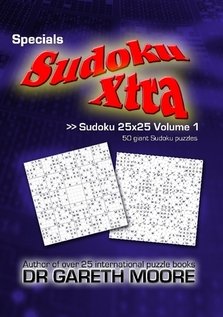 I’ve had many, many, many requests over the past years for a book of giant 25×25 Sudoku puzzles, so I have now finally made just such a book available!
I’ve had many, many, many requests over the past years for a book of giant 25×25 Sudoku puzzles, so I have now finally made just such a book available!
Right at the moment it’s only available in printed form, but I’ll have download copies available in the next couple of days – as soon as I’ve added a purchase mechanism to SudokuXtra.com in fact!
I’ve decided that I’m going to make a series of similar books of particular requested puzzles, all of which will be branded as “Sudoku Xtra Specials”. In this way I can stay organised by keeping all of my download/printed content under the ‘Sudoku Xtra’ heading. It means that you’ll always be able to find all of my new content in one place, without searching around my various sites.
This book is probably the nicest collection of 25×25 puzzles you can find, if you’re a fan of such things. Every puzzle has really nice 8-way symmetry – having noticeable patterns in puzzles like this is pretty unusual, and it can help with the solve too. Just as in my magazines, I’ve thought about what’s sensible in a puzzle like this so they can all be solved without needing pencilmarks. How exactly would you go about making A-Y pencilmarks in each individual square anyway?!
If you get hold of it please do let me know any thoughts you have on it. In the same way as for Sudoku Xtra magazine, it’s designed to be printed at home on either an all-together or a page-by-page basis. And if you get a pre-printed version from Lulu or Amazon.com (already complete but waiting on listing now) then it’s on a large A4 (Lulu) or 8″x10″ (Amazon) page, so there’s plenty of room to write in the solutions.
If there are other books of puzzles you’d like to see, please let me know in the comments here or on the Sudoku Xtra forums – feel free to repeat any requests you’ve made before! Next up is 16×16 Sudoku but after that it’s all open. I was thinking of doing Inequality Sudoku third, but what do you think?
Outside Sudoku
Jan 14th
Here’s something new (for me at least) – an Outside Sudoku puzzle. This one’s 6×6, just to get the ball rolling, but I have some larger ones (including some Samurai ones) ready for Sudoku Xtra issue 3!
The numbers outside the grid reveal some, none or all of the numbers that go somewhere in that same row or column anywhere up to the first bold line encountered – in other words, they go in that row/column of the adjacent bold-lined region. If more than one number is given then the order need not necessarily be the same as that shown.
For example, look at the top-left. The 4 and the 1 both go somewhere in the first three squares of the top row, but not necessarily in that order. Below them the 6 goes in the first three squares of its row, and at the bottom-left of the puzzle the 4 and 5 go into the bottom two squares of the left-most column.
Then just follow through as a regular Sudoku until it is solved. Good luck! ![]()
Inequality Sudoku
Dec 4th
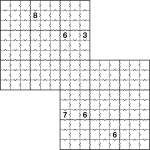
Inequality 2-grid Samurai Sudoku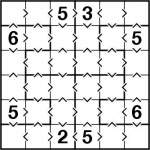
Inequality jigsaw 6×6 Sudoku puzzle
On the Sudoku Xtra forums Marilyn suggested the great idea of an inequality Samurai puzzle for issue 2, so I’ve been having a look at doing this. And here’s the first result!
I’ve started off with a regular 6×6 jigsaw Sudoku, but have added inequalities, just to get you warmed up, then I’ve included my first ever Samurai Inequality Sudoku puzzle, albeit a 2-grid one for now.
You’ll notice in both puzzles here that I have included all inequality arrows, so you have far more information than you need – this is deliberate, to make them easier! On the 6×6 puzzle there are five really nice diamond shapes in the centre area, but in general I think having all the arrows is ugly (or lazy!) so I don’t plan to include them again in future (just as I’ve never included them in past published inequality/Futoshiki puzzles).
The rules of Inequality Sudoku are pretty simple – just place the numbers as you would in a regular Sudoku (or regular Jigsaw Sudoku in the 6×6 case), but obey the less-than (”<”) and greater-than (”>”) signs between squares. These indicate that the value of the number in a square is either less than or greater than its neighbour. And that’s it! ![]()
Good luck!
Jigsaw Sudoku
Oct 30th
I’m adding features back in to my new puzzle assistant front end code so today I thought I’d post the standard Jigsaw Sudoku puzzle that was my test subject – just fit 1-9 into each row, column and bold-lined shape.
Just a Sudoku
Oct 30th
I haven’t posted here for a while, but it doesn’t mean I haven’t been working on various puzzle projects. One of the things I have been doing is upgrading my puzzle assistant code to be easier to use and more integrated than ever before, and the first part of testing this is to make a plain and simple vanilla Sudoku. So here it is. It’s very easy.
Meanwhile, the recent US Sudoku Championship hit the news not just for its $25,000 (£15,000) prize pot but also because it seems one of the three advanced level finalists cheated to get to the final (and win $3,000 / £1,800), possibly because the organisers seem to have allowed people to have all sorts of electronic devices with them whilst solving. The cheques have been held whilst they work out what happened.
Solving Sudoku using Robots!
Sep 2nd
Not a puzzle in itself, but I came across something related to Sudoku that’s so technically impressive that I just had to post about it.
There are plenty of online or interactive Sudoku solvers, and even some real-world ones which take the pages of a book, scan it in and then solve. SudokuGrab for iPod/iPhone is one popular example, whilst other people have used a combination of Lego and a webcam to scan in and solve entire books.
But how about this? A Sudoku solver robot which you can build yourself, and doesn’t even need a computer to drive it – it runs directly from a single Mindstorms Lego robotics kit. It’s unbelievable to watch it work, using a single point light sensor which the robot waves back and forth over the paper to build an image – there is no Lego webcam which can be integrated with the Mindstorms robotic kit. And then, as if it wasn’t already impressive enough, it uses a real pen to write in the solution.
It’s just amazing – take a look at the robot!
Stepping up – Three-away Sudoku!
Jul 21st
In a possibly inevitable next move (although in this case, I think, a probable conclusion to the theme rather than a stepping stone!) I thought I’d try out Three-away Sudoku, where black markers indicate all neighbouring squares with a difference of 3. With a 9×9 puzzle this still allows somewhat interesting 1-4-7, 2-5-8 and 3-6-9 chains to be used, although of course as you decrease the quantity of numbers that can fit in a chain so you start to lose the longer connected chains which I personally find so interesting.
Other than the three-away markers this is a regular 9×9 Sudoku puzzle, so just place 1 to 9 into each row, column and 3×3 box. Squares with a thick black bar between have a difference of 3 (e.g. 1&4), and those without a thick black bar between have a difference which is not 3.
An idea I have in mind to try next is to mix consecutive and two-away Sudoku in the same grid – I think any other combinations would be too confusing to play, although I suppose you could insert small numbers between squares to show selected differences which might make an interesting but possibly too mechanical variant. For me, I don’t want to have to stop and think about the rules I’m applying – in a good puzzle they should become intuitive really quickly (even if, in some cases, they are a little complex to learn they must become second nature for the puzzle to succeed – or so I find!).
Good luck! ![]()
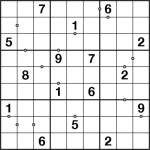
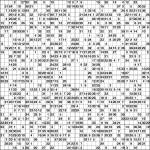
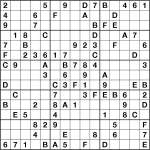
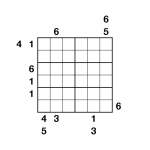
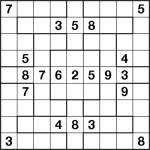
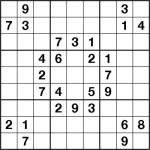

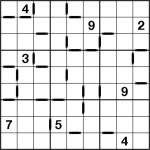

Recent Comments